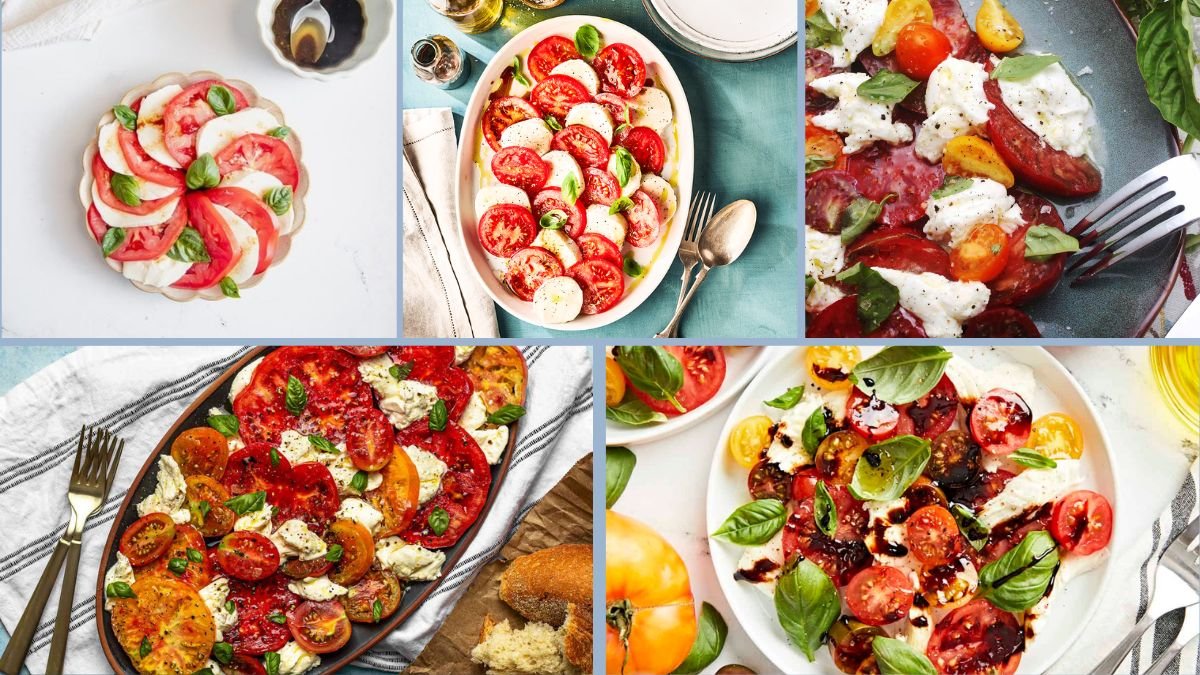The Caprese salad (Insalata Caprese) is a dish that embodies the essence of Italian cooking: simplicity, quality, and balance. Traditionally made with tomatoes, mozzarella, fresh basil, olive oil, and salt, this salad is deceptively simple yet deeply flavorful when prepared with care.
While commonly served as an appetizer or side, Caprese can also stand as a light main course, especially in vegetarian diets. However, the minimalist nature of the dish means there’s no room to hide errors. A subpar tomato or watery mozzarella can turn this classic into a disappointment.
In this article, we’ll explore 6 essential tricks to help you make the best vegetarian Caprese salad at home. No meat, no shortcuts—just real ingredients and thoughtful technique.
Trick 1: Choose Tomatoes at Their Peak
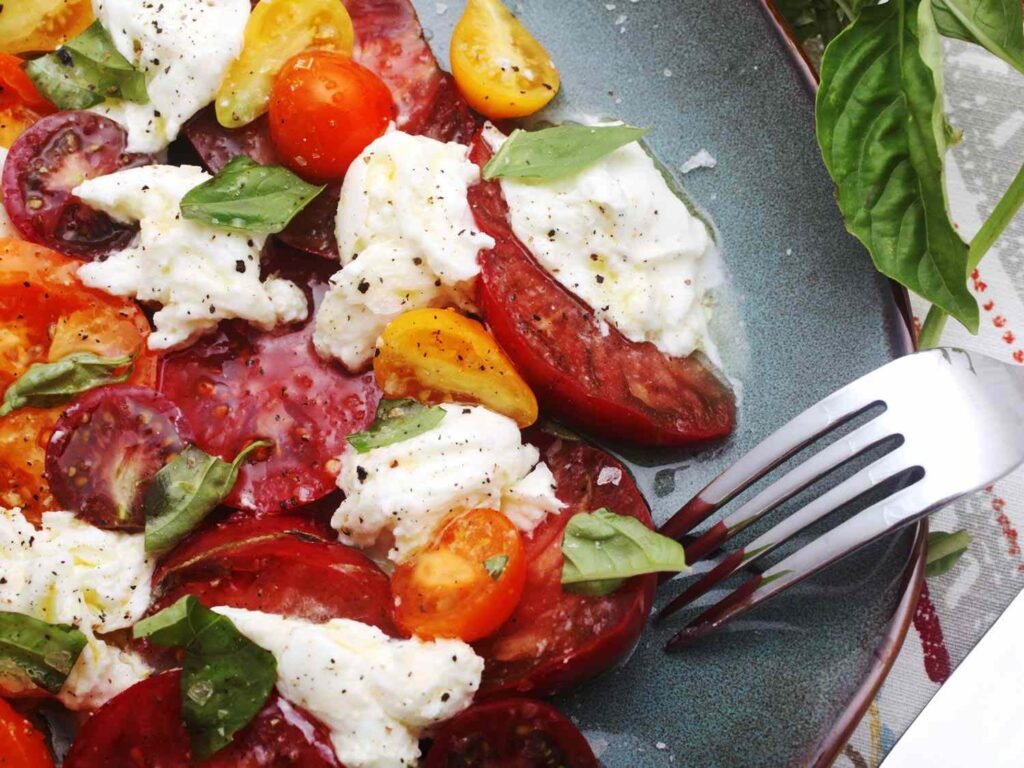
Tomatoes are the star of Caprese salad. Their texture, juiciness, and sweetness determine the entire tone of the dish.
How to Choose the Right Tomatoes:
- Use vine-ripened tomatoes. These tend to be the most flavorful and aromatic.
- Look for heirloom or beefsteak tomatoes. They are large, fleshy, and have a complex flavor profile.
- Check for firmness and color. A ripe tomato should be fragrant, slightly soft to the touch, and evenly colored—avoid green streaks unless using green heirlooms intentionally.
- In off-season months, opt for cherry or grape tomatoes, which retain more flavor in winter.
Tip: Never refrigerate tomatoes before using them. Cold temperatures dull their natural sugars and alter their texture.
Trick 2: Use High-Quality, Fresh Mozzarella
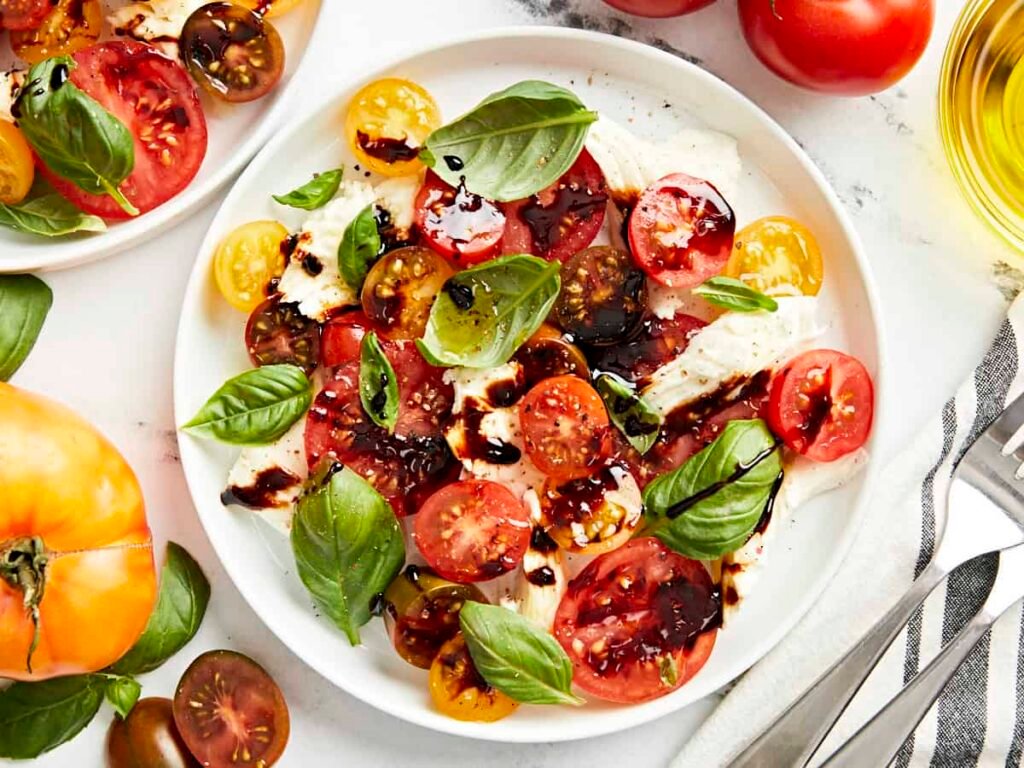
The second essential component of a Caprese salad is mozzarella, and the quality here is equally critical. Because we’re avoiding non-vegetarian elements like traditional buffalo mozzarella (which may contain animal rennet), focus on vegetarian-friendly options made with plant-based or microbial rennet.
Choosing the Best Vegetarian Mozzarella:
- Look for “fresh mozzarella” labeled as suitable for vegetarians (check the ingredients).
- Opt for water-packed mozzarella balls—they’re soft, creamy, and ideal for slicing.
- Avoid shredded or low-moisture mozzarella, which is meant for pizza and lacks the delicate texture required for a Caprese.
- Vegan alternatives: Use cashew mozzarella or almond-based soft cheese for a dairy-free version.
Cutting tip: Use a serrated knife or cheese wire to slice mozzarella cleanly without tearing.
Why it matters: Creamy, mild mozzarella balances the acidity of tomatoes and unites the dish with its soft texture.
Trick 3: Layer with Purpose, Not Just for Looks
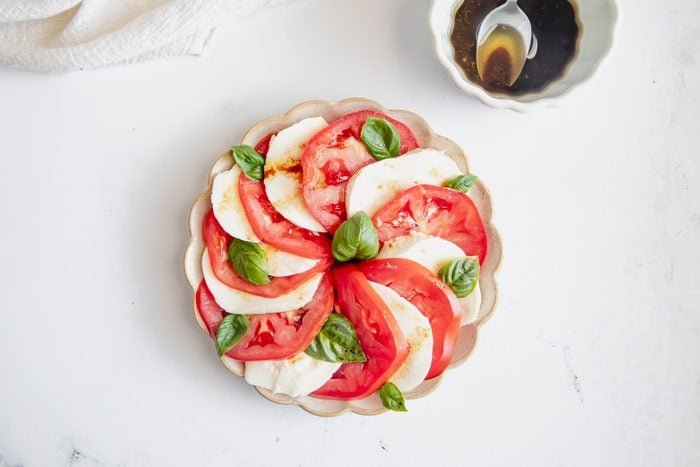
Many people assemble Caprese salads like a flat row of alternating ingredients. While this looks visually appealing, it can lead to a disconnected flavor experience.
Better Layering Techniques:
- Overlap tomato and mozzarella slices slightly so flavors merge with each bite.
- Tuck fresh basil leaves between each layer—not just on top. This ensures consistent flavor and aroma.
- Add a pinch of salt between layers, not just on top, to distribute seasoning evenly.
Optional Style: Try a “stacked Caprese” by layering rounds vertically or serve it as a chopped Caprese bowl for casual dining.
Why it matters: Layering impacts flavor distribution. Intentional assembly enhances taste and presentation.
Trick 4: Use Fresh Basil and Handle It Gently
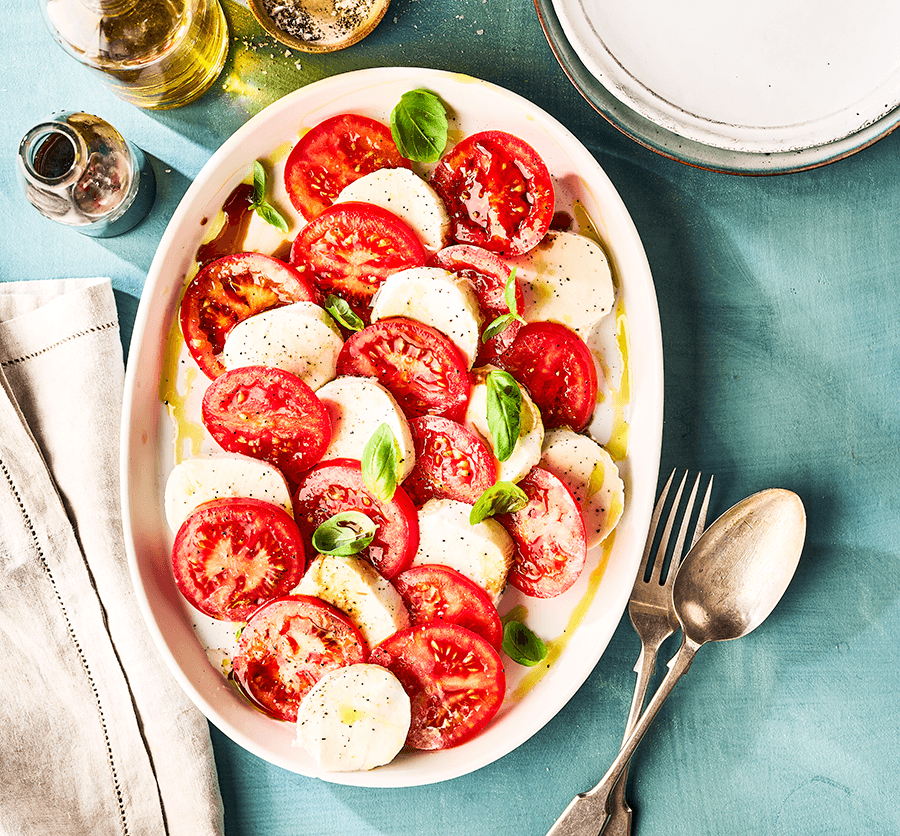
Basil is more than just a garnish—it brings fragrance, freshness, and balance. However, mishandling basil can bruise the leaves and cause discoloration.
Best Basil Practices:
- Use fresh, whole leaves. Avoid pre-chopped or dried basil.
- Pick medium to large leaves for more impact and flavor.
- Tear the leaves gently by hand instead of cutting with a knife to prevent bruising.
- Add basil just before serving, especially in hot weather, to keep it fresh and green.
Alternate varieties: Try purple basil for visual flair or lemon basil for a citrus twist.
Why it matters: Basil contributes both aroma and flavor. Improper handling can make it look wilted or blackened.
Trick 5: Choose the Right Olive Oil and Seasoning
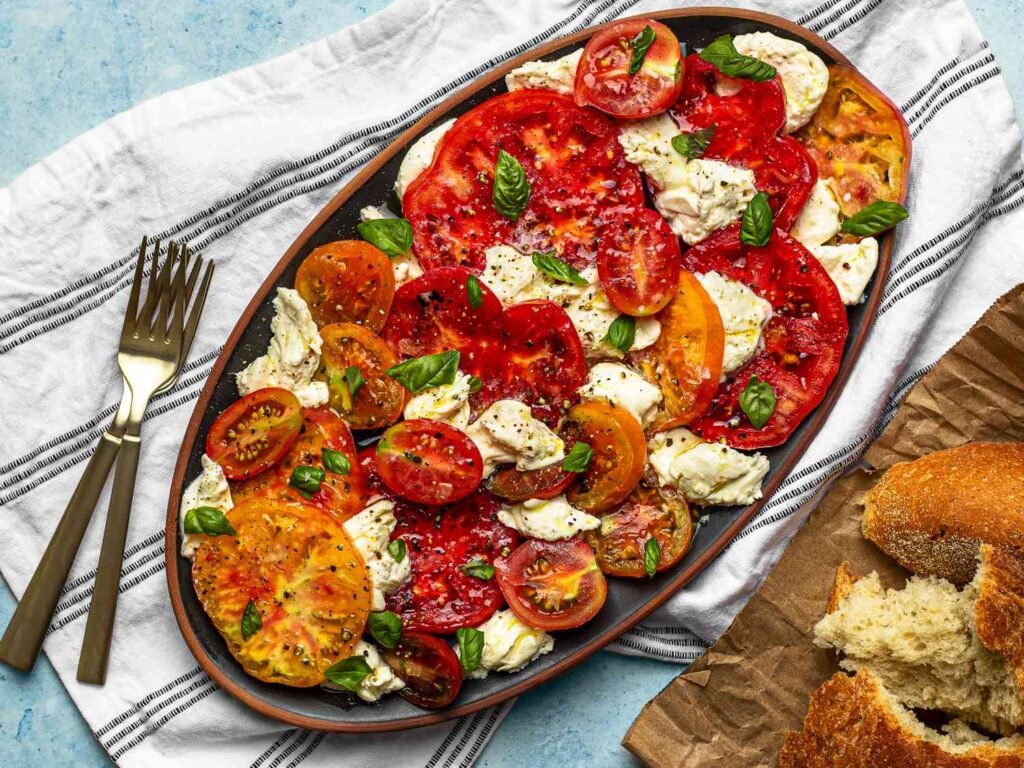
Extra virgin olive oil (EVOO) acts as the binding agent in a Caprese salad. It adds richness and depth while carrying the flavors of tomato, mozzarella, and basil.
What to Look for in Olive Oil:
- Use cold-pressed extra virgin olive oil. It should have a peppery, grassy aroma and a slightly bitter finish.
- Taste before using. Good olive oil should be flavorful but not overpowering.
- Drizzle, don’t drown. Use just enough to coat the layers.
Don’t Forget the Seasoning:
- Sea salt or flaky salt adds texture and enhances tomato sweetness.
- Freshly cracked black pepper gives a gentle kick.
- Optional: A few drops of balsamic glaze can add sweetness and contrast (avoid regular vinegar, which may overpower the dish).
Why it matters: High-quality oil and salt elevate the dish. Low-grade oil or bland seasoning can ruin the subtle flavor balance.
Trick 6: Serve at the Right Temperature and Time
Timing and temperature are crucial for a Caprese salad. Serving it too cold dulls the flavors, while waiting too long can cause sogginess.
Ideal Serving Conditions:
- Serve at room temperature for best flavor.
- Assemble no more than 30 minutes before serving.
- If preparing in advance, store components separately and assemble just before mealtime.
- Add salt and dressing just before serving to avoid water release from tomatoes.
Presentation Tip: Use a chilled plate in summer to keep the salad fresh without refrigerating the ingredients.
Why it matters: Serving at the right temperature preserves freshness, texture, and flavor integrity.
Bonus Variations (All Vegetarian):
Although traditional Caprese has only a few ingredients, modern kitchens allow for creativity while preserving its vegetarian identity.
Flavorful Caprese Twists:
- Avocado Caprese: Add sliced avocado for creaminess and healthy fats.
- Grilled Vegetable Caprese: Include grilled zucchini or eggplant slices for a warm version.
- Pesto Caprese: Swap basil leaves with a drizzle of vegetarian pesto.
- Fruit Caprese: Try peaches, strawberries, or watermelon in place of tomatoes for a sweet variation.
- Caprese Skewers: Great for parties—thread tomato, mozzarella, and basil onto skewers.
These variations maintain the core balance of acidity, fat, and freshness, but allow for seasonal and regional creativity.
Sample Vegetarian Caprese Salad Recipe
Ingredients:
- 3–4 ripe tomatoes (heirloom or vine-ripened)
- 200g fresh vegetarian mozzarella
- 15–20 fresh basil leaves
- 2 tbsp extra virgin olive oil
- Sea salt and freshly cracked black pepper to taste
- Optional: balsamic glaze or avocado slices
Instructions:
- Slice the tomatoes into medium-thick rounds.
- Slice the mozzarella evenly.
- Layer tomato and mozzarella in a circular or overlapping pattern.
- Tuck basil leaves between each layer.
- Drizzle with olive oil evenly across the salad.
- Season with salt and pepper.
- Add optional garnishes like balsamic glaze or avocado slices.
- Serve immediately at room temperature.
Conclusion: Caprese Salad as an Art Form
Caprese salad proves that less is more. When executed correctly—with the right tomatoes, mozzarella, basil, olive oil, and technique—it becomes a celebration of ingredients, not just a starter dish.
Each of the six tricks above contributes to elevating this classic Italian salad into something exceptional:
- Start with ripe, juicy tomatoes
- Use high-quality vegetarian mozzarella
- Layer thoughtfully for flavor
- Handle basil with care
- Choose premium olive oil and season wisely
- Serve at the right temperature and time
By following these steps, you can create a Caprese salad that is fresh, flavorful, visually stunning, and fully vegetarian—perfect for any season or occasion.
Suggestions for Thesis Expansion
If you are writing a thesis around vegetarian or Mediterranean cuisine, consider expanding this topic with:
- Ingredient origin studies (e.g., evolution of mozzarella types or heirloom tomato cultivation)
- Nutritional comparisons (Caprese with dairy vs. Caprese with vegan cheese)
- Cultural interpretations (regional differences in Italy or fusion versions)
- Sensory analysis (taste tests on different oil types or mozzarella brands)
- Sustainability comparisons (impact of plant-based cheese alternatives)
